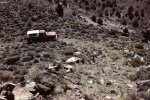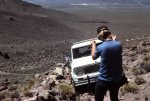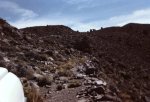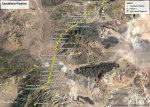Explorer 1
Explorer 1
Came across an old 4wd exploring pamplet listing what appeared to be "forgotten" places to explore in Western Nevada. One such place was the old Candelaria Pipeline. While much can be found about the town of Caldelaria, little seems to be written about the 27 mile pipeline that laid from the While Mountains to the town.
Back in 1881 the booming silver town of Candallaria had a problem in that the nearest water was 7 miles away and besides being hard to bring in over a bumpy road hauled in barrels, it was also poor quality as it had a high salt content. Once it arrived in Caldallaria it was so expensive it cost $2.50 for enough water to take a bath. Now to give you some idea what that would be in today's dollars, I found a web site that only went back to 1913 and had it calculate what 2.50 in 1913 would be worth in today's dollars, it came out to $57.18!!!
So the Nevada Governor went back to New York and found some investors to finance a pipeline from the nearest source of reliable good water, the White mountains to Candallera, 27 miles. It took almost 1 1/2 years to complete the 4 inch pipeline which was buried 4 feet underground. Twelve years later in the severe winter of 1894 parts of the pipeline froze and burst. It then took 2 years to fully repair the line but by then over $20,000,000 (Twenty Million) of silver had been taken out of Caldallaria and the mines shut down shortly thereafter. Using the same inflation calculator for this value of silver from 1913 in today's dollars that was $457,416,161!
I had a hard time finding the trail along the old pipeline and after a few false starts we found the two track trail and started making our way up in into Pinchot Canyon. Near the top we read that parts of the old pipeline were exposed and could be found. The trail up the beginning of the canyon progressively deteriorated, to the point that I choose compound low and at one point had to use the rear locker. The book describes the trail at this point at three difficult staircases. The first staircase was described as "Not Bad" the second, "considerably worse" and the third, "In less than 0.3 miles this road climbs only 400 feet, but that 400' can best be described as a giant stone staircase. It is one of the two roughest jeep trails described in this book." ( WHERE IS MY CHEROKEE WHEN I NEED IT!)
Over the past 25 years it looks like things have even become worse. Here is a picture of what I believe is the FIRST Staircase, you can see just how steep it is. Besides steep, the spring runoff has removed just about every bit of soil and all that remains is loose sharp large rocks.

At this point we hiked up and found the remnants of the old pipeline. Interesting that it was a spiral wrap pipe held together by rivets


The pipeline continues up the hill where it then traveled down to the small reservoir. Water costs dropped to pennys a gallons at this point. Shortly after the pipeline was repaired though, the mines started shutting down.
It appears the road is impossible to follow once on top. Maybe some day with a 4wd ATV I might see if I can follow it to the old ghost town.
Lots of unanswered questions as to how they made and installed this pipeline, Seem so very little is recoreded about it.
Thanks,
Fred
Explorer 1
Back in 1881 the booming silver town of Candallaria had a problem in that the nearest water was 7 miles away and besides being hard to bring in over a bumpy road hauled in barrels, it was also poor quality as it had a high salt content. Once it arrived in Caldallaria it was so expensive it cost $2.50 for enough water to take a bath. Now to give you some idea what that would be in today's dollars, I found a web site that only went back to 1913 and had it calculate what 2.50 in 1913 would be worth in today's dollars, it came out to $57.18!!!
So the Nevada Governor went back to New York and found some investors to finance a pipeline from the nearest source of reliable good water, the White mountains to Candallera, 27 miles. It took almost 1 1/2 years to complete the 4 inch pipeline which was buried 4 feet underground. Twelve years later in the severe winter of 1894 parts of the pipeline froze and burst. It then took 2 years to fully repair the line but by then over $20,000,000 (Twenty Million) of silver had been taken out of Caldallaria and the mines shut down shortly thereafter. Using the same inflation calculator for this value of silver from 1913 in today's dollars that was $457,416,161!
I had a hard time finding the trail along the old pipeline and after a few false starts we found the two track trail and started making our way up in into Pinchot Canyon. Near the top we read that parts of the old pipeline were exposed and could be found. The trail up the beginning of the canyon progressively deteriorated, to the point that I choose compound low and at one point had to use the rear locker. The book describes the trail at this point at three difficult staircases. The first staircase was described as "Not Bad" the second, "considerably worse" and the third, "In less than 0.3 miles this road climbs only 400 feet, but that 400' can best be described as a giant stone staircase. It is one of the two roughest jeep trails described in this book." ( WHERE IS MY CHEROKEE WHEN I NEED IT!)
Over the past 25 years it looks like things have even become worse. Here is a picture of what I believe is the FIRST Staircase, you can see just how steep it is. Besides steep, the spring runoff has removed just about every bit of soil and all that remains is loose sharp large rocks.

At this point we hiked up and found the remnants of the old pipeline. Interesting that it was a spiral wrap pipe held together by rivets


The pipeline continues up the hill where it then traveled down to the small reservoir. Water costs dropped to pennys a gallons at this point. Shortly after the pipeline was repaired though, the mines started shutting down.
It appears the road is impossible to follow once on top. Maybe some day with a 4wd ATV I might see if I can follow it to the old ghost town.
Lots of unanswered questions as to how they made and installed this pipeline, Seem so very little is recoreded about it.
Thanks,
Fred
Explorer 1
Last edited:




